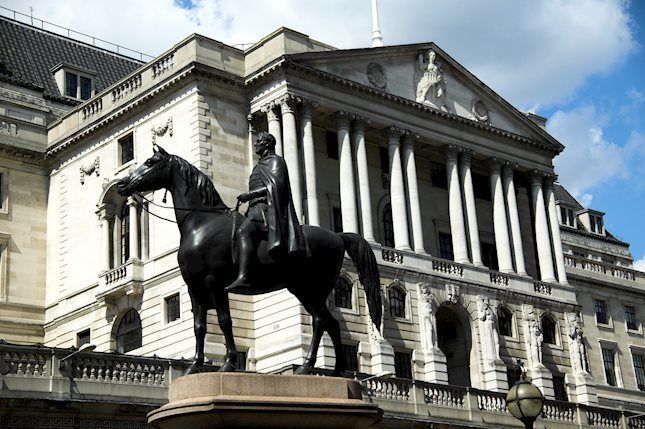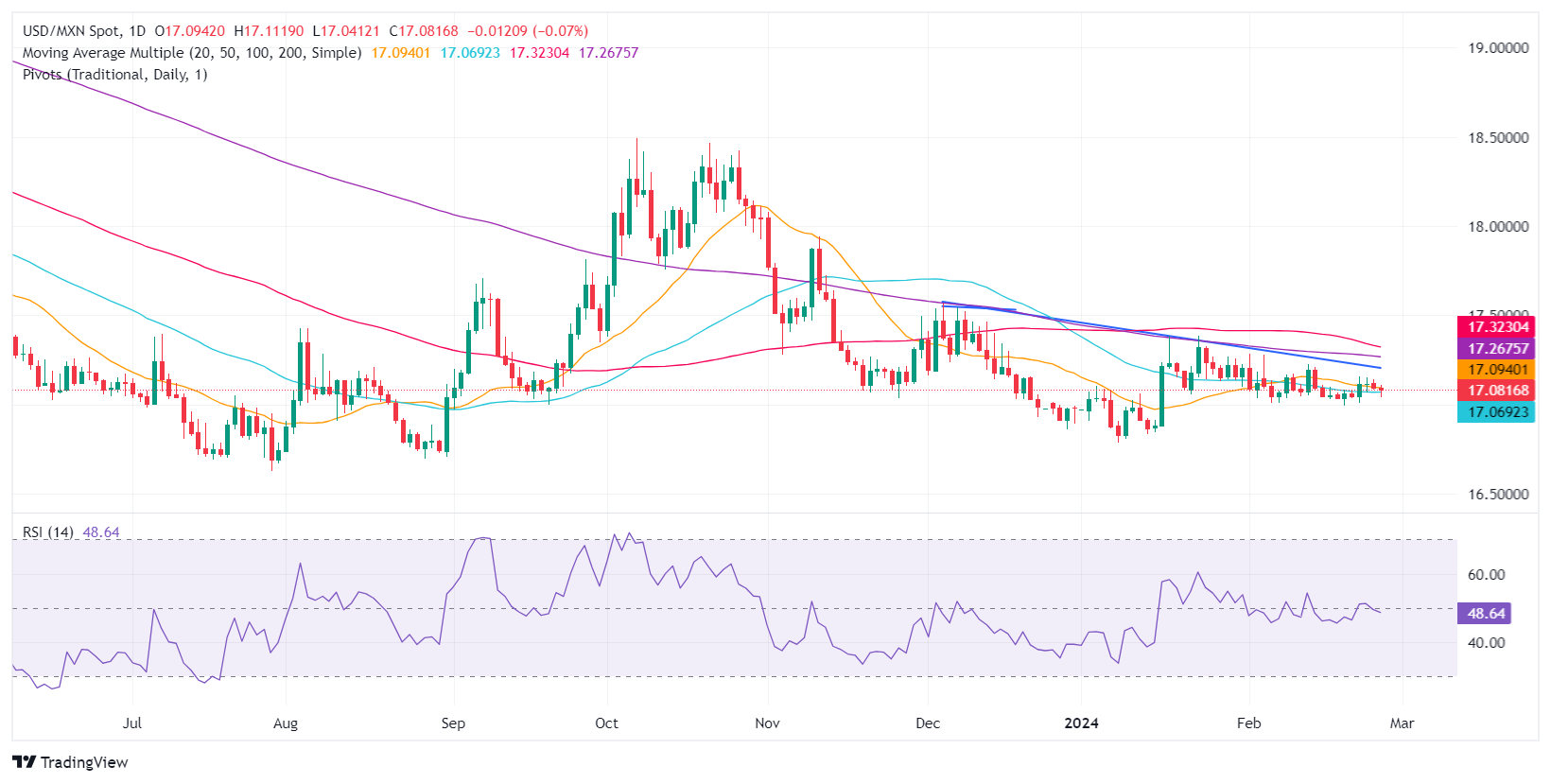Most recent article: Mexican Peso dives as Banxico signals possible policy easing
- Mexican Peso gains modestly as US Dollar weakens further despite pressure from rising US Treasury yields.
- Mexico's January trade deficit and potential Banxico rate cut speculation influence USD/MXN dynamics.
- Economic slowdown signs and CPI dip support Banxico's potential easing, hinting at upcoming volatility for the Peso.
Mexican Peso registers modest gains against the US Dollar as the latter remains weak, extending its losses to two straight days against a basket of six currencies, the so-called US Dollar Index (DXY). Nevertheless, a jump in US Treasury bond yields is capping the Peso’s advance, with the USD/MXN trading at 17.05, down 0.25%.
Mexico reported the Balance of Trade for January, which revealed the country posted a trade deficit of $302 million dollars, seasonally-adjusted, as announced by the National Statistics Agency (INEGI). The data failed to extend the USD/MXN losses amid speculation that the Bank of Mexico (Banxico) could ease monetary policy.
In an interview with El Economista, Pamela Diaz Loubet, BNP Paribas economist for Mexico, commented, “We maintain the forecast that they (Banxico) will apply a cut in March.” She said that in the latest minutes guidance for future actions, Banxico will surely explain that the March cut will be presented “to maintain flexibility and the gradual approach to cuts.”
The economic data in Mexico is expected to show an economic slowdown due to higher interest rates set by the Bank of Mexico (Banxico) at 11.25%. That, along with the latest report of the Consumer Price Index (CPI) dipping sharply for the first half of February, justifies the posture of three members of Banxico. The latest meeting minutes suggested that three policymakers are eyeing the first rate cut at the March meeting, which could put pressure on the Mexican Peso, opening the door for further upside on the USD/MXN exchange rate.
Across the border, US Durable Goods Orders plunged more than expected, while Home Prices reported by S&P/Case Shiller were mixed.
Daily digest market movers: Mexican Peso recovers as Banxico rate cut speculation grows
- Mexico posted a $302 million trade deficit in January when adjusted for seasonal swings.
- The latest inflation report in Mexico showed that headline and underlying inflation continued to dip toward Banxico’s goal of 3% plus or minus 1%, while economic growth exceeded estimates but finished below Q3’s 3.3%.
- Mexico’s Consumer Price Index (CPI) in the first half of February was 4.45%, down from 4.9% YoY.
- Mexico’s Core CPI slowed from 4.78% to 4.63% on an annual basis.
- Mexico’s GDP for Q4 2023 exceeded estimates of 2.4% YoY and hit 2.5%, less than Q3 2023 print of 3.3%.
- Economic trade issues between Mexico and the US could depreciate the Mexican currency if the Mexican government fails to resolve its steel and aluminum dispute with the United States. US Trade Representative Katherine Tai warned the US could reimpose tariffs on the commodities.
- In January, US Durable Goods Orders significantly declined to -6.1% MoM, exceeding the anticipated contraction of -4.5% and marking a steeper fall compared to December's -0.3% decrease.
- In December, the S&P/Case-Shiller Home Price Index indicated a monthly decline of -0.3%, a slight acceleration in the contraction pace from November's -0.2%. On an annual basis, home prices rose by 6.1%, surpassing both expectations and the growth rate from the previous month.
- The last meeting minutes of the US Federal Reserve (Fed) showed that policymakers remain hesitant to cut rates amid fears of a second round of inflation. They have expressed willingness to adjust policy when necessary but remain cautious, indicating no urgency to act. This stance is supported by current economic data suggesting strength in the economy, which could potentially revive inflationary pressure.
- Market players had trimmed the odds for the first 25 basis point (bps) rate cut in June, with odds lying at 53%, while 36% of investors expected the Fed to keep rates unchanged at the current level of 5.25%-5.50%.
Technical analysis: Mexican Peso stays firm as USD/MXN meanders around 50-day SMA
The USD/MXN slid below the 17.10 area, hoovering around the 50-day Simple Moving Average (SMA) after posting back-to-back days of losses. Even though the pair dipped to a three-day low at 17.04, it remains trading sideways, awaiting a fresh catalyst to gather direction.
If sellers drag the spot price below the 17.00 figure, that will pave the way to test the current year-to-date low of 16.78, followed by the 2023 low of 16.62. Otherwise, buyers moving in could lift the USD/MXN above 17.10, followed by the psychological 17.20 figure, ahead of key resistance levels seen at the 200-day SMA at 17.26 and the 100-day SMA at 17.33.
USD/MXN Price Action – Daily Chart
Mexican Peso FAQs
What key factors drive the Mexican Peso?
The Mexican Peso (MXN) is the most traded currency among its Latin American peers. Its value is broadly determined by the performance of the Mexican economy, the country’s central bank’s policy, the amount of foreign investment in the country and even the levels of remittances sent by Mexicans who live abroad, particularly in the United States. Geopolitical trends can also move MXN: for example, the process of nearshoring – or the decision by some firms to relocate manufacturing capacity and supply chains closer to their home countries – is also seen as a catalyst for the Mexican currency as the country is considered a key manufacturing hub in the American continent. Another catalyst for MXN is Oil prices as Mexico is a key exporter of the commodity.
How do decisions of the Banxico impact the Mexican Peso?
The main objective of Mexico’s central bank, also known as Banxico, is to maintain inflation at low and stable levels (at or close to its target of 3%, the midpoint in a tolerance band of between 2% and 4%). To this end, the bank sets an appropriate level of interest rates. When inflation is too high, Banxico will attempt to tame it by raising interest rates, making it more expensive for households and businesses to borrow money, thus cooling demand and the overall economy. Higher interest rates are generally positive for the Mexican Peso (MXN) as they lead to higher yields, making the country a more attractive place for investors. On the contrary, lower interest rates tend to weaken MXN.
How does economic data influence the value of the Mexican Peso?
Macroeconomic data releases are key to assess the state of the economy and can have an impact on the Mexican Peso (MXN) valuation. A strong Mexican economy, based on high economic growth, low unemployment and high confidence is good for MXN. Not only does it attract more foreign investment but it may encourage the Bank of Mexico (Banxico) to increase interest rates, particularly if this strength comes together with elevated inflation. However, if economic data is weak, MXN is likely to depreciate.
How does broader risk sentiment impact the Mexican Peso?
As an emerging-market currency, the Mexican Peso (MXN) tends to strive during risk-on periods, or when investors perceive that broader market risks are low and thus are eager to engage with investments that carry a higher risk. Conversely, MXN tends to weaken at times of market turbulence or economic uncertainty as investors tend to sell higher-risk assets and flee to the more-stable safe havens.
Information on these pages contains forward-looking statements that involve risks and uncertainties. Markets and instruments profiled on this page are for informational purposes only and should not in any way come across as a recommendation to buy or sell in these assets. You should do your own thorough research before making any investment decisions. FXStreet does not in any way guarantee that this information is free from mistakes, errors, or material misstatements. It also does not guarantee that this information is of a timely nature. Investing in Open Markets involves a great deal of risk, including the loss of all or a portion of your investment, as well as emotional distress. All risks, losses and costs associated with investing, including total loss of principal, are your responsibility. The views and opinions expressed in this article are those of the authors and do not necessarily reflect the official policy or position of FXStreet nor its advertisers. The author will not be held responsible for information that is found at the end of links posted on this page.
If not otherwise explicitly mentioned in the body of the article, at the time of writing, the author has no position in any stock mentioned in this article and no business relationship with any company mentioned. The author has not received compensation for writing this article, other than from FXStreet.
FXStreet and the author do not provide personalized recommendations. The author makes no representations as to the accuracy, completeness, or suitability of this information. FXStreet and the author will not be liable for any errors, omissions or any losses, injuries or damages arising from this information and its display or use. Errors and omissions excepted.
The author and FXStreet are not registered investment advisors and nothing in this article is intended to be investment advice.
Recommended content
Editors’ Picks

EUR/USD stays under pressure near 1.0550 on renewed USD strength
EUR/USD holds lower ground near 1.0550 on Wednesday. The US Dollar benefits from rising US Treasury bond yields and the cautious market mood, forcing the pair to stay on the back foot. Several Federal Reserve policymakers will be delivering speeches later in the day.

GBP/USD declines toward 1.2650, erases UK CPI-led gains
GBP/USD loses its traction and retreats toward 1.2650 on Wednesday. Although the stronger-than-expected inflation data from the UK helped Pound Sterling gather strength, the risk-averse market atmosphere caused the pair to reverse its direction.

Gold stays below $2,640 as US yields rebound
Gold struggles to hod its ground and trades below $2,640 on Wednesday. Following Tuesday's slide, the benchmark 10-year US Treasury bond yield stays in positive territory, making it difficult for XAU/USD to building on its weekly gains.

Why is Bitcoin performing better than Ethereum? ETH lags as BTC smashes new all-time high records
Bitcoin has outperformed Ethereum in the past two years, setting new highs while the top altcoin struggles to catch up with speed. Several experts exclusively revealed to FXStreet that Ethereum needs global recognition, a stronger narrative and increased on-chain activity for the tide to shift in its favor.

Sticky UK services inflation to keep BoE cutting gradually
Services inflation is set to bounce around 5% into the winter, while headline CPI could get close to 3% in January. That reduces the chance of a rate cut in December, but in the spring, we think there is still a good chance the Bank of England will accelerate its easing cycle.

Best Forex Brokers with Low Spreads
VERIFIED Low spreads are crucial for reducing trading costs. Explore top Forex brokers offering competitive spreads and high leverage. Compare options for EUR/USD, GBP/USD, USD/JPY, and Gold.
